Since spring is in the air, it may as well be on your plate. Our Spring Pasta Primavera is a tastier twist (if I do say so, myself) on this classic pasta recipe. Celebrate warmer weather with a delicious blend of seasonal veggies – peas, asparagus, spinach, mushrooms, and artichokes – blanketed in creamy parmesan sauce. This delicate dish is surprisingly fast and filling.
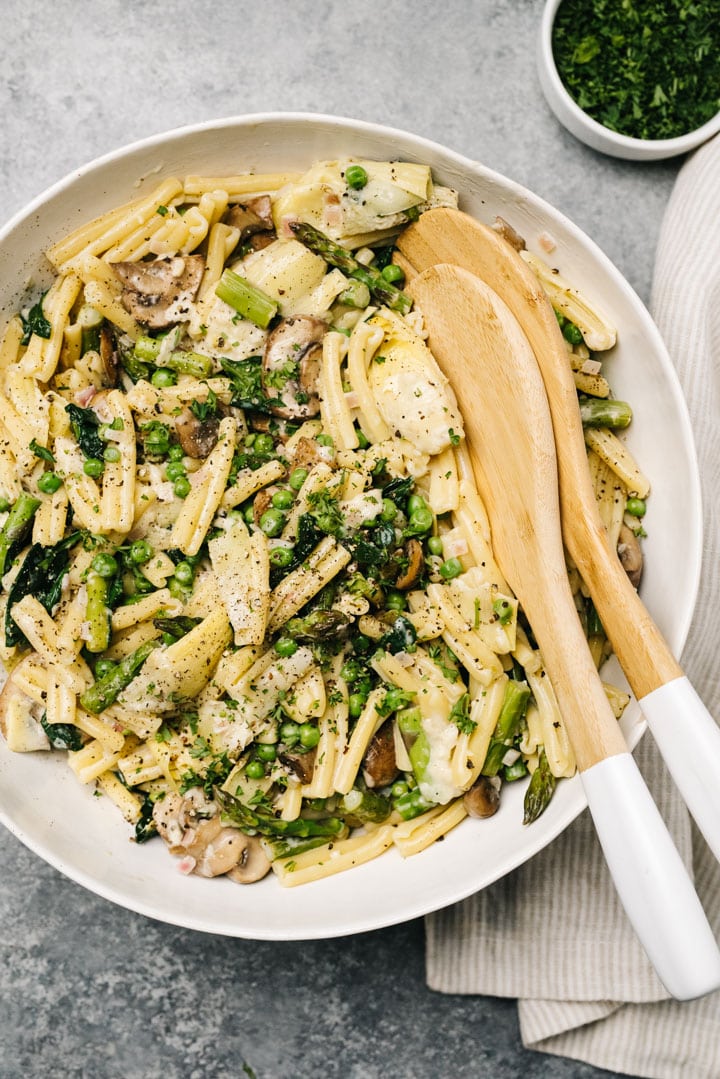
Jump to:
You gotta love a dish that ticks most – if not every – box. Spring Pasta Primavera is one such meal. This easy pasta recipe is:
- Fast: as written, it’s ready in about 30 minutes. If I’m adding protein, my air fryer helps me multitask with quick, hands-free cooking to stay on schedule.
- Filling: aside from the carb-licious pasta, the veritable cornucopia of vegetables provides plenty of fiber to help keep bellies fuller, longer.
- Frugal: you can probably score most of the ingredients for this primavera recipe in your pantry! Canned artichokes, frozen peas, and pretty much any pasta you’ve got are all recommended.
- Flexible: want (or need) to swap veggies? Only have spaghetti on hand? Totally fine. No one’s judging.
- Cheese: it has cheese. The end.
What is Pasta Primavera?
Clock another win for Italian-Americans. Of course we came up with this one. We took one look at light, bright, fresh seasonal vegetables and thought “Those need more carbohydrates.” Then we took one look at traditional Alfredo sauce and thought “That needs more full fat dairy.” And thus, a star is born.
Now I jest, but pasta primavera is typically a much lighter creamy pasta dish than many others (including heavier mass-produced Alfredo sauces and my own creamy white sauce). While we have some protein add-in suggestions below, it is traditionally a vegetarian dish that relies on fresh veggies just cooked to fork tender status.
The usual culprits in pasta primavera recipes are peas, carrots, red bell peppers, and occasionally broccoli. But with spring in the air, so thick you can taste it (the pollen, y’all – I can literally taste the pollen – already.*), I needed a celebratory seasonal variation ASAP before I went back into hibernation.
(*Note: I did not include crushed up Benadryl in the list of ingredients but that does not mean I did not seriously consider it…)
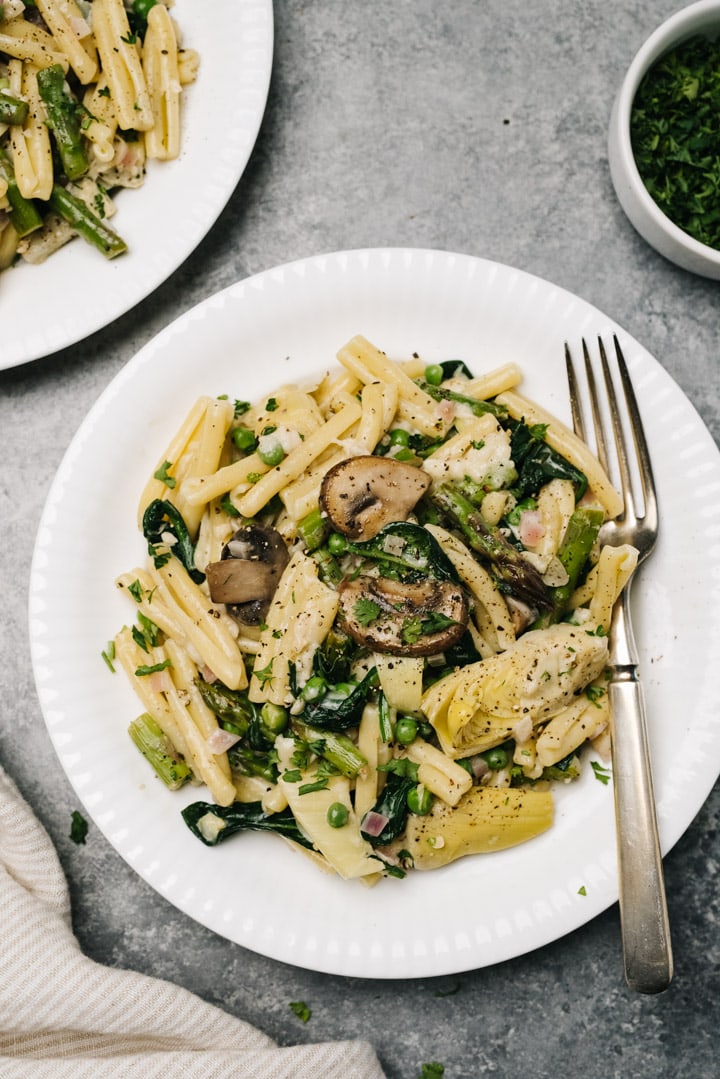
Primavera Sauce Key Ingredients
Alliums: use finely minced or chopped shallots and garlic for best flavor and texture.
White Wine: use dry, never sweet – consider Sauvignon Blanc, Pinot Grigio, or an un-oaked Chardonnay. Avoid Riesling and Moscato. Cooking wine is fine, but table wine is better. If wine isn’t available, substitute an equivalent amount of chicken broth along with 1 tablespoon lemon juice.
Heavy Cream: do NOT substitute half and half or milk – you need that fat!
Pasta Water: this “liquid gold” contains the leftover starch (and salt) from cooking your pasta. It’s that same starchy water that is going to help emulsify the dairy fats you need to make a silky, smooth sauce.
Parmesan Cheese: choose a fresh block of good quality cheese. It MUST be finely shredded/grated, preferably using a microplane.
How to Make Pasta Primavera
Ready for a spring awakening? Spring Pasta Primavera isn’t just a delicious medley of bright seasonal vegetables balanced by a decadent cream sauce, it’s a primer in simple step-by-step preparation. Pasta, then veggies, then sauce, then toss. From peas to parmesan, it’s one dish you’ll come back to each spring.
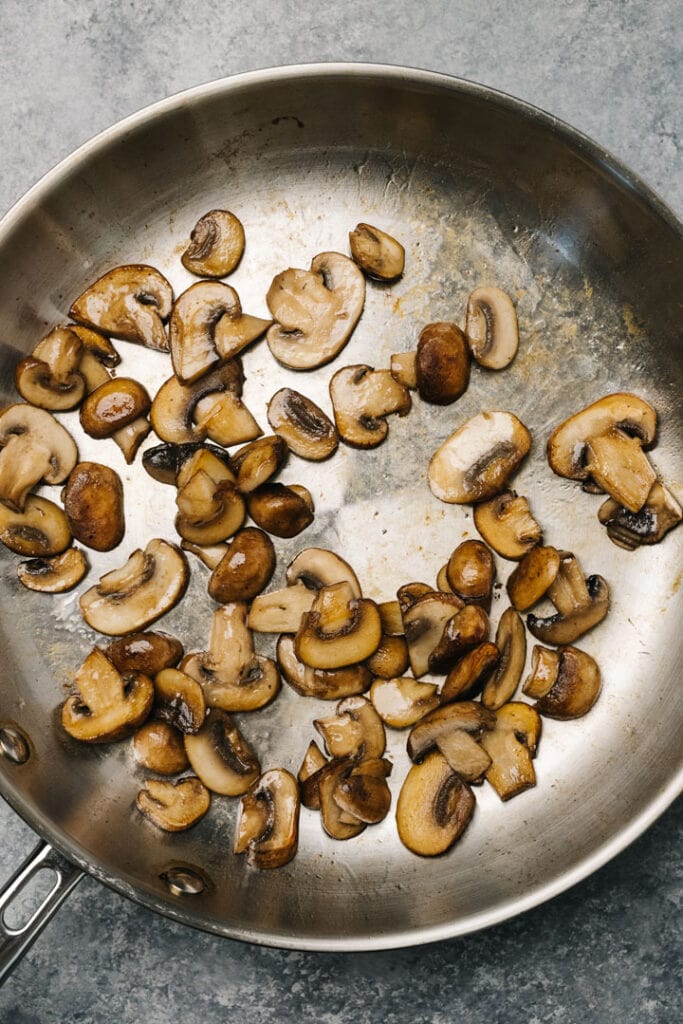
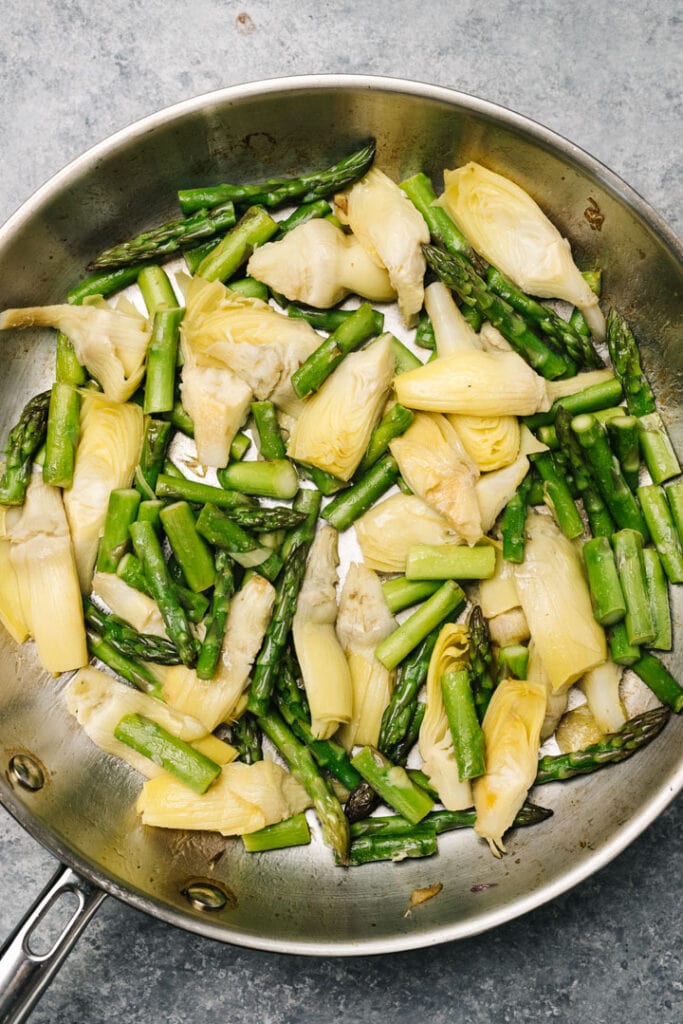
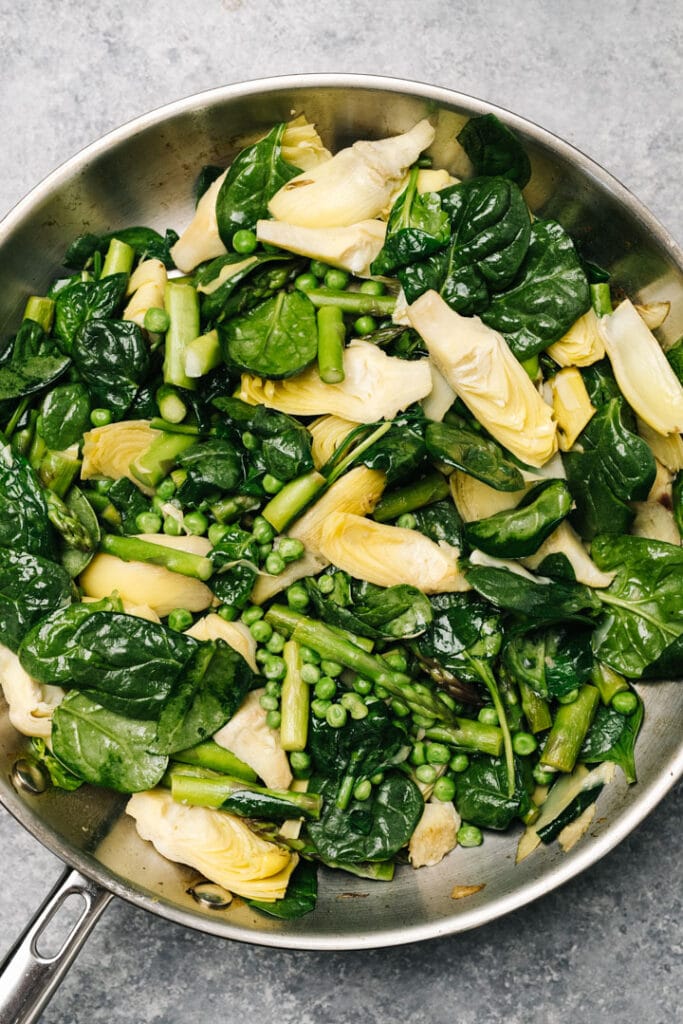
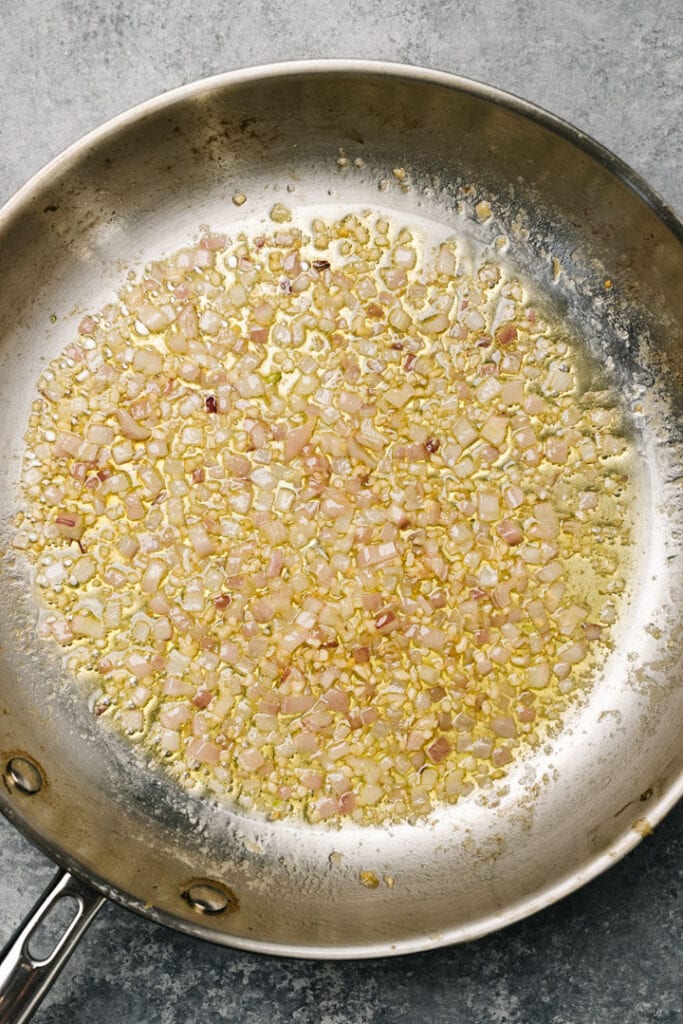
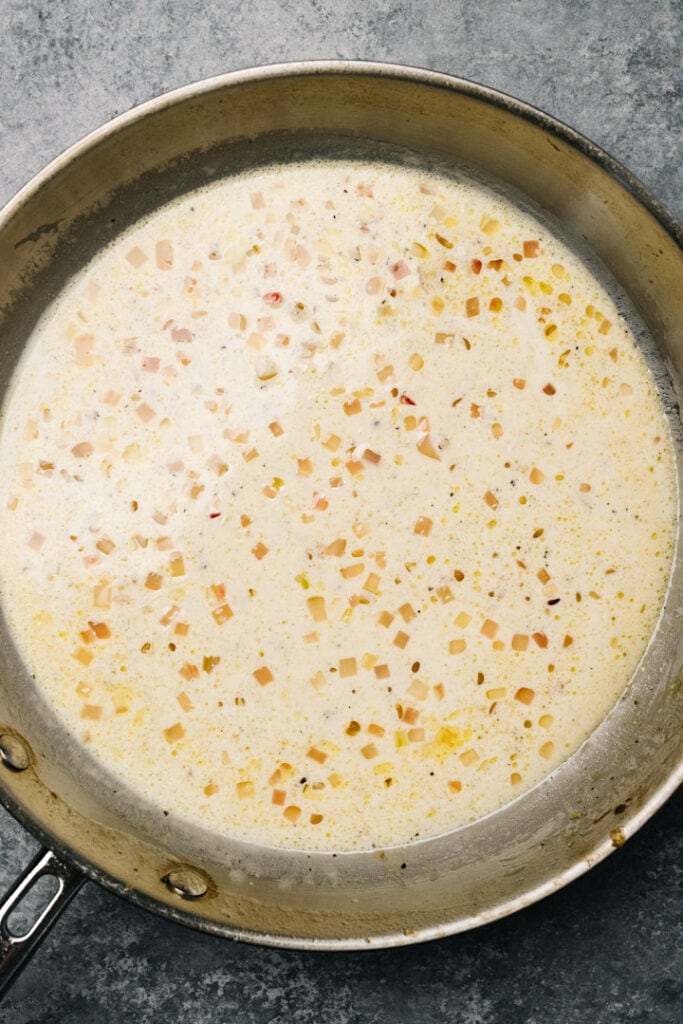
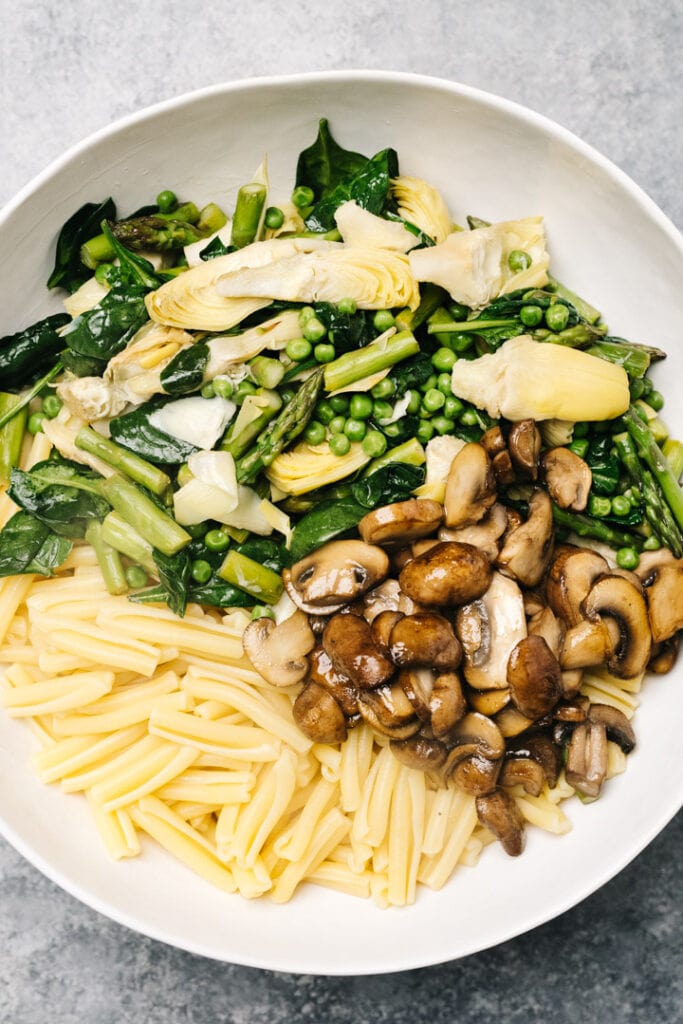
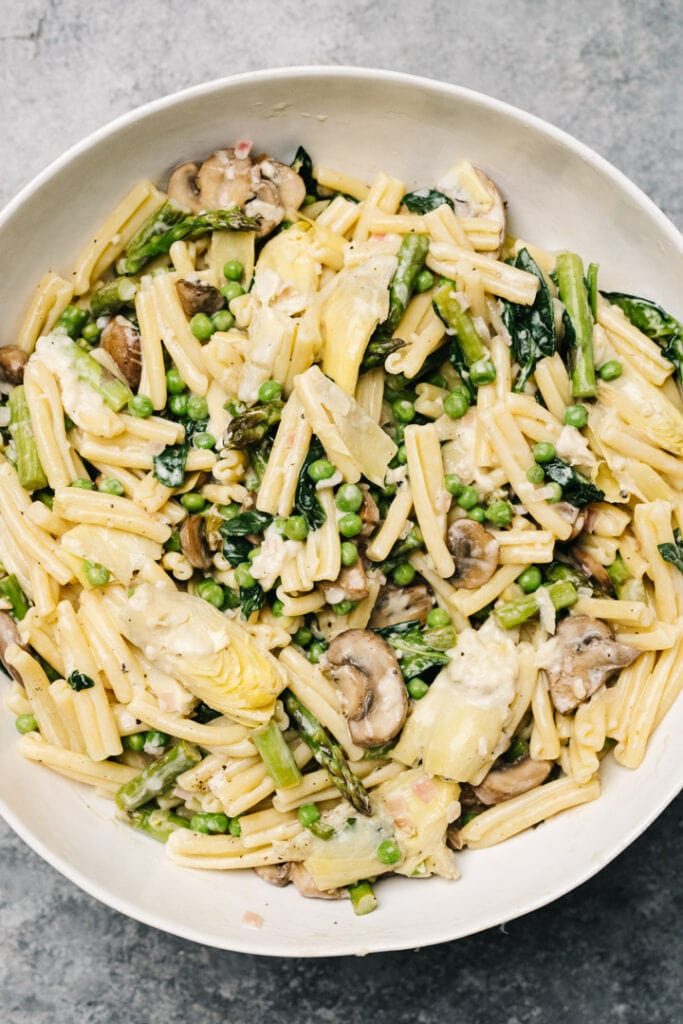
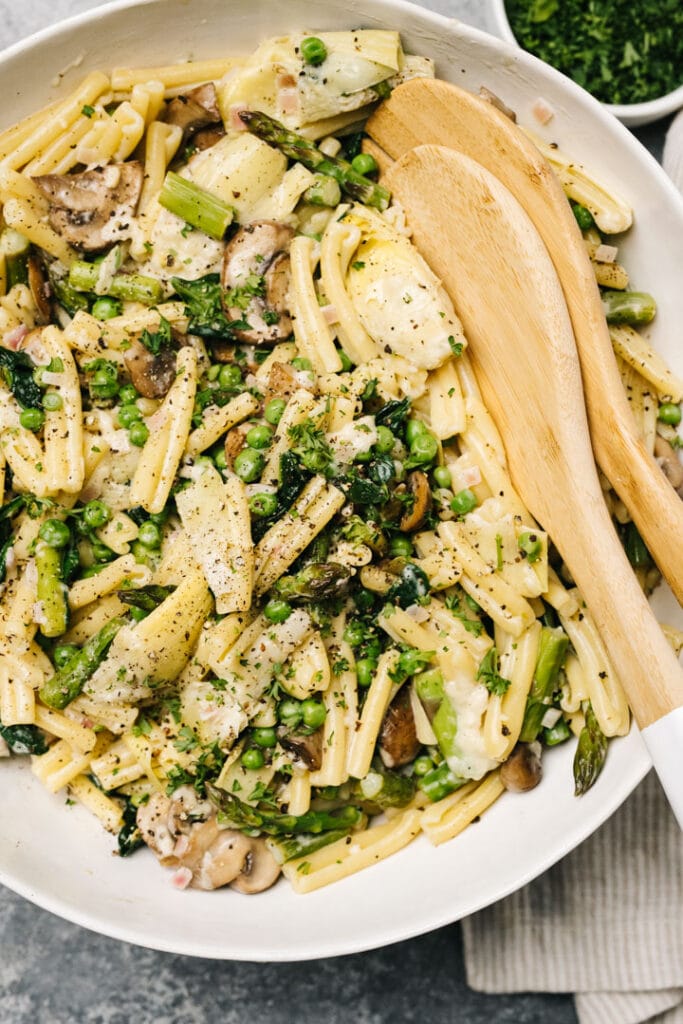
- Cook the pasta in heavily salted water until al dente. Reserve 1 cup pasta water, drain, and set aside.
- Brown the mushrooms in olive oil until they release their liquids and crisp around the edges (about 10 minutes). Remove using a slotted spoon and add to the bowl with the drained pasta.
- Add asparagus and artichoke hearts to the skillet and cook until the asparagus is just barely fork tender, about 6 minutes.
- Stir in the peas and spinach and cook until the peas defrost and the spinach wilts. Scrape the cooked vegetables into the pasta bowl.
- In the same skillet, cook the shallots and garlic in butter until the shallots are soft and the garlic is lightly golden brown.
- Deglaze the pan with white wine, and simmer to reduce the volume and concentrate the flavor. Stir in heavy cream, then remove from heat.
- Pour the sauce over the pasta and vegetables and gently toss to combine.
- Add a splash of the reserved pasta water along with one-third of the parmesan cheese; gently toss until cheese melts. Repeat with rest of the cheese in ⅓ c portions. Keep tossing until sauce is smooth and creamy. You’re relying on the heat from the pasta to melt the cheese into the sauce – just keep tossing until the sauce emulsifies into creamy goodness.
- Garnish with fresh chopped herbs – we like parsley and/or basil – and lots of ground pepper. Enjoy!
Chef’s Tips!
- Cook the pasta to 1 minute below al dente (see your package instructions) – it will finish cooking when you toss it with the pasta water and sauce.
- Season the pasta water liberally with sea or kosher salt – at least 1 tablespoon of kosher salt per quart (4 cups) of water. It should taste like ocean water. This will help season your pasta from within.
- Save that pasta water! You shouldn’t need to set aside more than 1 cup, but it’s a crucial element for a sauce with tons of body and flavor.
- The ONE place to really splurge in this recipe is the parmesan. Finely grate the cheese using a microplane into paper thin shreds that will easily melt into the sauce.
- Wait to season with salt – the pasta water and parmesan will add plenty of salt to start. If you dive in and feel the dish needs more salt, add just a pinch over the prepared dish and gently stir.
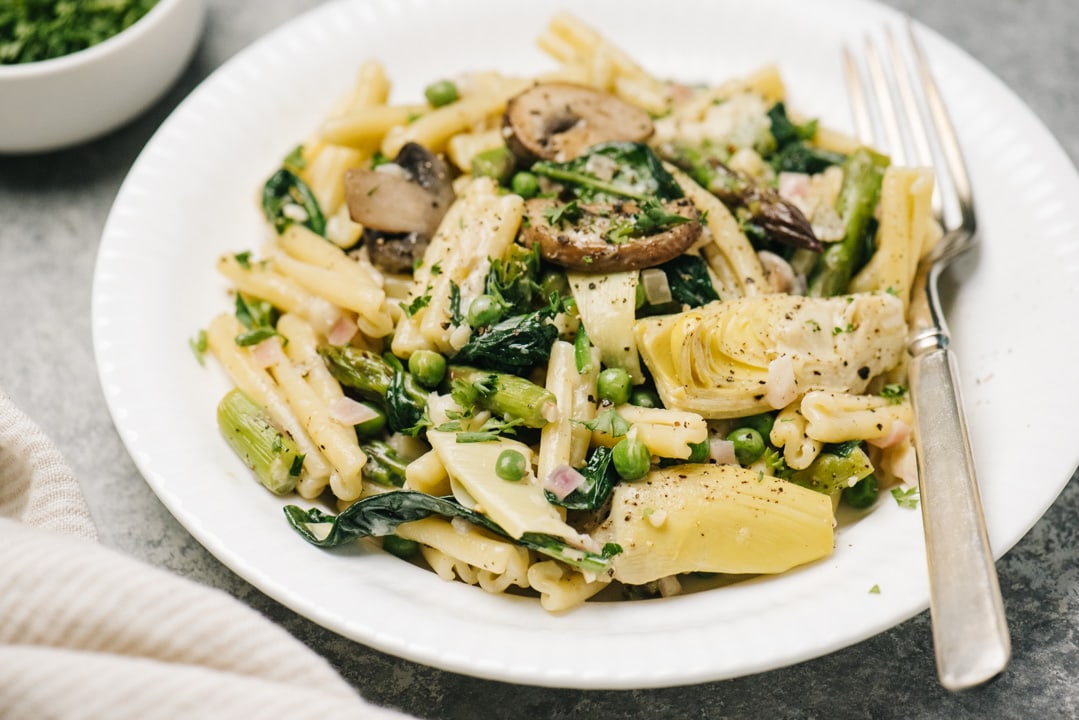
What’s the Best Pasta Shape to Use?
Primavera is one of those magical pasta recipes where nearly any shape works. Here with chunkier vegetables, we like a chunkier pasta shape. But really, “use what you have” or what you prefer is going to be the best choice.
Veggie Variations for Pasta Primavera
With a nod to the fact that yes, I understand “primavera” translates to spring, the beauty of this dish is that it can also translate to any season and works with all your favorite veggie combinations, so get creative!
- Slice up grilled portobellos and let mushrooms to take centerstage.
- You can use leek instead of shallot to maintain the flavor. Avoid white, yellow, or red onions – they’ll overwhelm the delicate sauce.
- Corn and zucchini are a great summer combo, or you can go all out with a full sheet pan of roasted summer veggies.
- Oven roasted broccoli and cauliflower florets are great together.
- Keep the peas and go classic! Use diced carrot and red bell pepper instead of asparagus and artichokes.
- One swap I don’t recommend is the spinach. Like onions, other cooked leafy greens have a stronger flavor which can upset the balance of the dish.
Want Protein?
Keep pasta primavera light and bright with chicken or shrimp. Air Fryer Shrimp is ridiculously easy and perfectly cooked every time!
Simply seasoned chicken will let your veggies shine. For boneless skinless breasts, follow the grilling instructions in this recipe, but cook fully, 6-7 minutes per side. For boneless skinless thighs, grill over high heat for 4-5 minutes per side. (Your chicken is done when your instant read thermometer hits 165°F.)
More Cravable Creamy Pasta Dishes
- Creamy Pasta Sauce with Roasted Vegetables
- Easy Tomato Cream Sauce
- Ricotta Pasta with Peas and Leeks
- Butternut Squash Mac and Cheese
- Creamy Pesto Sauce
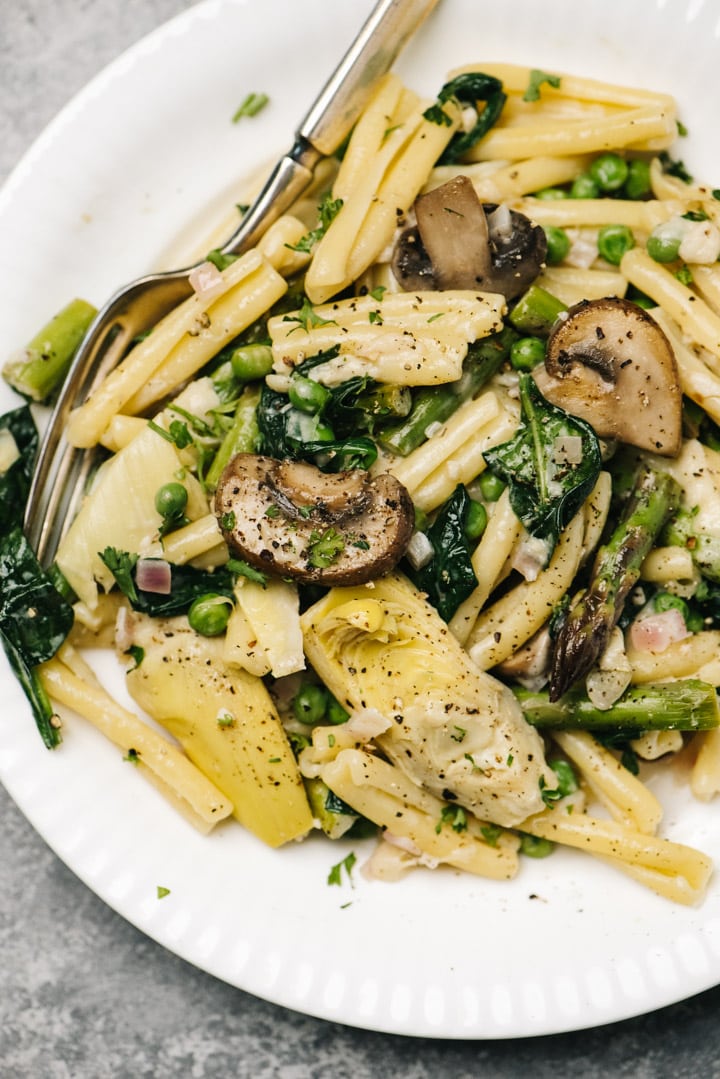
Did you make our spring pasta primavera? I’d love to know how it turned out! Leave a comment and a rating below.
While you’re at it, let’s be friends – follow me on Pinterest and Instagram for the latest and greatest.
Recipe
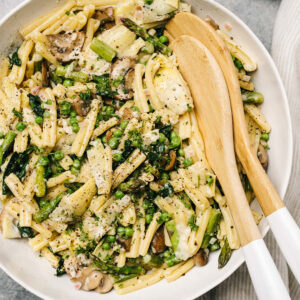
Spring Pasta Primavera
Print Recipe Rate this Recipe Pin RecipeIngredients
- 1 lb pasta
- 1 tablespoon kosher salt
- 3 tablespoon olive oil, divided
- 8 oz mushrooms, thinly sliced
- 1 lb asparagus, ends trimmed, sliced into 1” pieces
- 1 14.5-oz can quartered artichoke hearts, well drained
- 1 cup frozen peas
- 2 cups baby spinach
- 2 tablespoon butter
- 1 medium shallot, finely chopped
- 2 cloves garlic, minced
- ¾ cup dry white wine
- ½ cup heavy cream
- ½ teaspoon ground pepper
- 1 cup finely shredded parmesan cheese
Instructions
- Cook the pasta in water seasoned with 1 tablespoon kosher salt until al dente. Reserve 1 cup pasta water, then drain and set aside.
- Heat a 12” skillet over medium high heat. Add the olive oil and heat until shimmering.
- Add the mushrooms and cook until the edges are just starting to turn golden brown, about 10 minutes. Remove using a slotted spoon and add to the pasta bowl, or transfer to a plate if the pasta isn’t yet fully cooked.
- Add the remaining tablespoon of olive oil to the skillet and give it 30 seconds to heat up. Add the asparagus and artichoke hearts, then toss to coat in the fat. Saute, stirring frequently, until the asparagus is bite tender, about 6 minutes.
- Stir in the frozen peas and spinach. Saute, tossing frequently, until the peas are defrosted and the spinach is wilted. Scrape the mixture into the bowl with the cooked pasta and mushrooms.
- Add the butter to the skillet and heat until it melts then foams. Add the shallot and garlic and cook until the shallot is translucent, 3 minutes.
- Pour in the white wine to deglaze the pan. Simmer until the wine reduces by half, 4-5 minutes. Stir in the heavy cream, then season with ground pepper.
- Pour the sauce over the pasta and vegetables and gently toss to combine. Add ⅓ c reserved pasta water and one-third of the parmesan cheese. Toss until the cheese melts, then add another third of the cheese; toss until the cheese melts and then add the remaining third cup of cheese. Keep tossing until the sauce is creamy and evenly distributed; if it’s too thick, add more pasta water. Taste for seasoning and adjust the salt.
- Serve immediately, garnished with chopped fresh parsley or basil and lots of ground pepper.


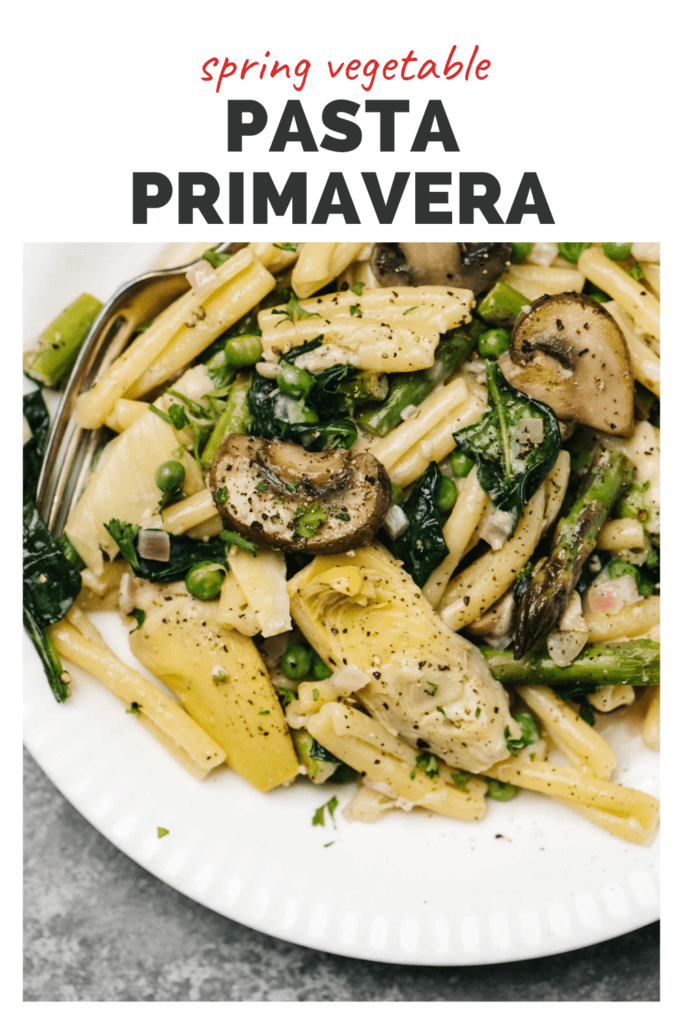
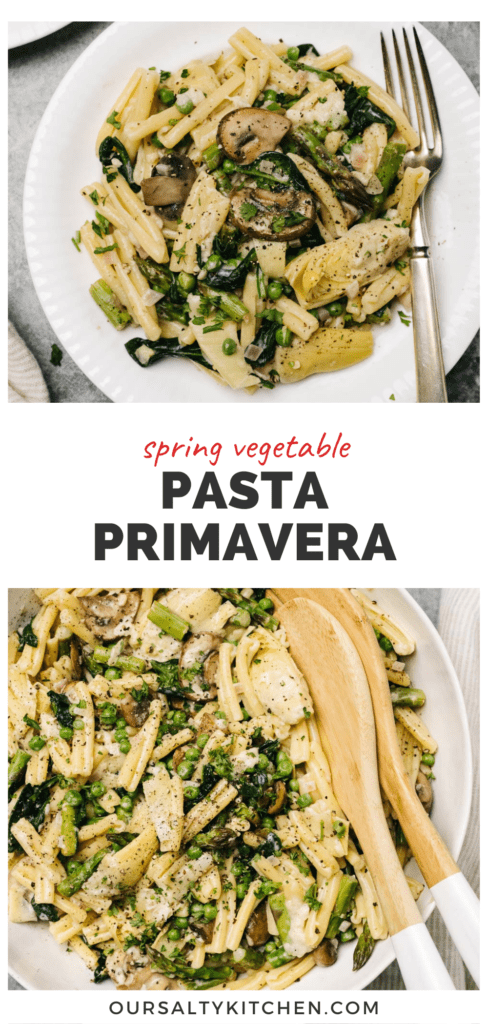

Lindsay | With Salt and Pepper
Pasta primavera is one of my most favorite childhood memory foods that my mom made all the time! I haven’t made it in years…this is a great reminder 😀